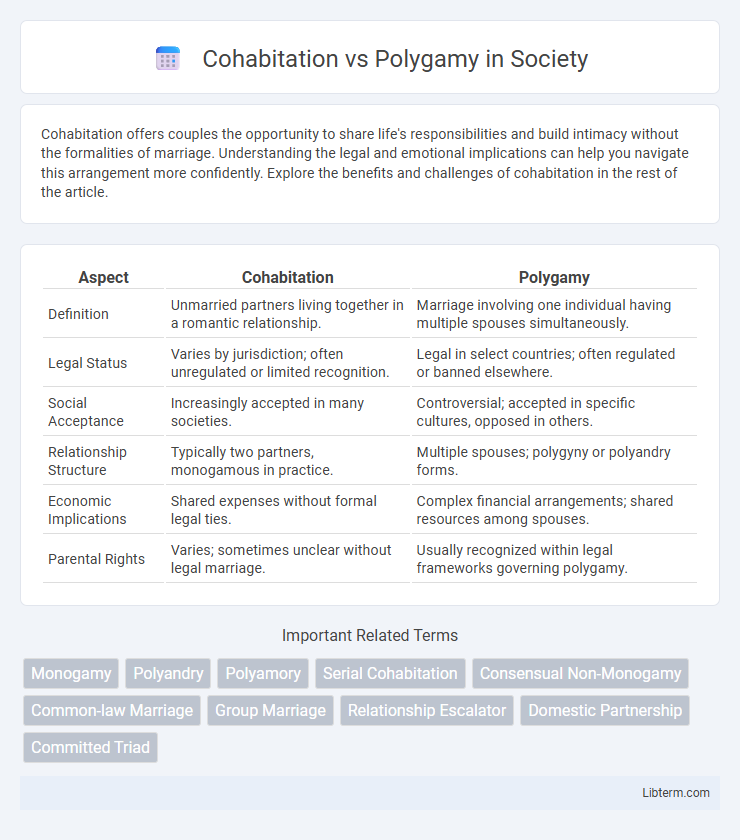Cohabitation offers couples the opportunity to share life's responsibilities and build intimacy without the formalities of marriage. Understanding the legal and emotional implications can help you navigate this arrangement more confidently. Explore the benefits and challenges of cohabitation in the rest of the article.
Table of Comparison
| Aspect | Cohabitation | Polygamy |
|---|---|---|
| Definition | Unmarried partners living together in a romantic relationship. | Marriage involving one individual having multiple spouses simultaneously. |
| Legal Status | Varies by jurisdiction; often unregulated or limited recognition. | Legal in select countries; often regulated or banned elsewhere. |
| Social Acceptance | Increasingly accepted in many societies. | Controversial; accepted in specific cultures, opposed in others. |
| Relationship Structure | Typically two partners, monogamous in practice. | Multiple spouses; polygyny or polyandry forms. |
| Economic Implications | Shared expenses without formal legal ties. | Complex financial arrangements; shared resources among spouses. |
| Parental Rights | Varies; sometimes unclear without legal marriage. | Usually recognized within legal frameworks governing polygamy. |
Understanding Cohabitation: Definition and Prevalence
Cohabitation refers to an arrangement where two individuals live together in a long-term relationship without being legally married, often sharing financial and domestic responsibilities. It is increasingly prevalent globally, especially among younger adults and in urban areas, as a flexible alternative to traditional marriage. Studies indicate that in countries like the United States and much of Europe, cohabitation rates have risen significantly over the past decades, reflecting changing social norms around partnership and family structures.
What is Polygamy? Types and Legal Status
Polygamy is the practice of having more than one spouse simultaneously, most commonly categorized into polygyny, where a man has multiple wives, and polyandry, where a woman has multiple husbands. This marital system is legally recognized in several countries across Africa, the Middle East, and parts of Asia, while remaining illegal in most Western nations. Legal status varies widely, with polygyny often permitted under customary or religious laws, whereas polyandry is rare and less commonly legalized.
Key Differences Between Cohabitation and Polygamy
Cohabitation involves two individuals living together in a domestic partnership without formal marriage, emphasizing personal choice and often equality between partners. Polygamy refers to a marital arrangement where one person has multiple spouses simultaneously, typically practiced in cultural or religious contexts with legal recognition in some regions. Key differences include the legal status, societal acceptance, and the number of partners involved, with cohabitation usually limited to two adults while polygamy encompasses multiple spouses under one marital contract.
Cultural and Religious Influences on Relationship Choices
Cohabitation and polygamy are deeply shaped by cultural and religious norms that influence societal acceptance and legality. In many Western cultures, cohabitation is increasingly common and socially accepted as a precursor or alternative to marriage, reflecting secular values and individual autonomy. Polygamy, often rooted in religious doctrines such as Islam and certain African traditional beliefs, remains legally restricted or taboo in most countries but continues to be practiced within communities where religious teachings uphold it as a legitimate family structure.
Legal Implications: Rights and Challenges
Cohabitation and polygamy present distinct legal implications regarding rights and challenges, as cohabitation typically involves two individuals living together without formal marriage, often facing limited legal protections in areas like property rights, inheritance, and parental responsibilities. Polygamy, being legally prohibited in many countries, poses significant challenges including criminal penalties, complications in spousal rights, and difficulties in child custody arrangements, where the law often fails to recognize multiple spouses. Legal systems predominantly prioritize monogamous marriages, resulting in cohabitants and polygamous families encountering significant barriers in accessing social benefits, healthcare decision-making authority, and legal recognition of family status.
Social Stigma and Acceptance: A Comparative View
Cohabitation is increasingly accepted across many Western societies, with surveys showing over 60% of adults view it as a normal step before marriage, reflecting reduced social stigma. Polygamy, by contrast, faces widespread legal restrictions and significant social disapproval due to cultural, religious, and ethical concerns in most countries, limiting its acceptance. Sociological studies reveal cohabitation correlates with higher social integration, while polygamous relationships often experience marginalization and legal challenges.
Impact on Children and Family Dynamics
Cohabitation often provides children with a more stable family environment compared to polygamy, where complex relationships and divided parental attention can affect emotional development and security. Family dynamics in polygamous households typically involve intricate power structures and sibling rivalries, influencing children's social and psychological well-being. Research indicates children in cohabiting families generally experience fewer conflicts and clearer parental roles, contributing positively to their overall stability.
Psychological and Emotional Considerations
Cohabitation often provides psychological benefits such as emotional intimacy and relationship stability without the legal complexities of polygamy, which can lead to heightened stress due to societal stigma and legal issues. Polygamous relationships may create emotional challenges like jealousy and competition among partners, impacting mental health and relationship satisfaction. Understanding these psychological and emotional dynamics is crucial for evaluating relationship structures and their effects on individual well-being.
Economic Factors in Cohabitation vs Polygamy
Cohabitation often involves shared living expenses and economic collaboration between partners, allowing for cost savings on housing, utilities, and daily necessities. Polygamy can result in complex financial obligations, as one individual supports multiple spouses and possibly numerous children, increasing the economic burden and necessitating substantial income or resource management. Economic stability in polygamous arrangements is contingent on the primary earner's capacity to provide, whereas cohabitation usually distributes financial responsibilities more evenly among partners.
Future Trends and Societal Perspectives
Future trends indicate a shift towards increased acceptance of cohabitation as a flexible, non-traditional family structure, reflecting evolving societal values around autonomy and gender equality. Polygamy remains legally and culturally restricted in many regions, but conversations about its recognition are emerging, particularly in multicultural societies. Societal perspectives are increasingly shaped by debates on individual rights, legal frameworks, and the impact of these relationships on social cohesion and child welfare.
Cohabitation Infographic

 libterm.com
libterm.com